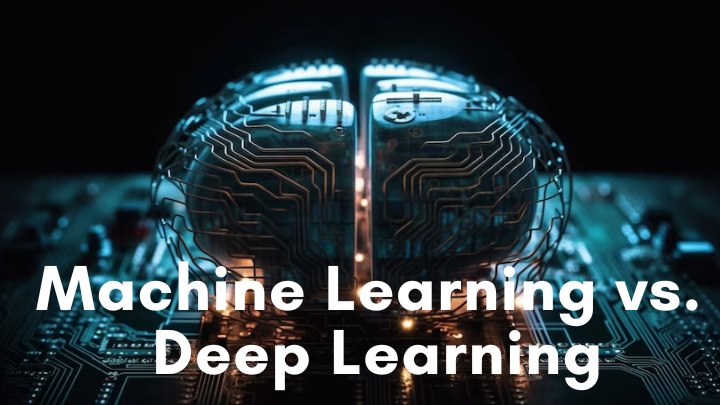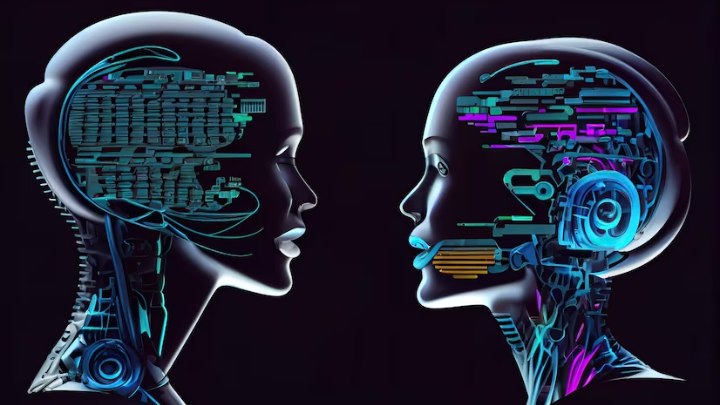
In the world of computers and artificial intelligence, there are two influential players: machine learning and deep learning. In this case study blog article, we will talk in-depth regarding Machine Learning vs. Deep Learning.
Think of them as two superheroes with unique strengths. Machine Learning is like the wise wizard who carefully chooses the right spells (algorithms) to solve problems. At the same time, deep learning is a superhero with a powerful suit (neural network) that can tackle super complex tasks.
In this showdown, we will uncover their differences in the simplest way possible so you can understand when to call upon the wizard or the superhero for your AI needs.
1. Architecture and Model Complexity
Architecture and model complexity in the context of machine learning and deep learning are like the blueprint and size of a building. Think of architecture as the design plan and model complexity as how intricate or straightforward the goal is.
Machine Learning
In machine learning, the architecture is like a simple one-story house plan. It’s simple, and you must decide how each room looks in advance. It would be best if you told the model what to focus on, which is called feature engineering.
Deep Learning
In deep learning, the architecture is more like designing a skyscraper. It is a lot more intricate and can have many floors, like layers in a neural network. Here, you don’t have to decide every detail; the model learns by itself. You feed it data, and it figures out what features are essential on its own.
If you have lots of data and a complex problem, deep learning, with its elaborate architecture, is the way to go. But if your problem is more superficial and you want more control, traditional machine learning with a simpler architecture could be the better choice.
It’s like choosing between a basic house or a skyscraper for your specific needs. When you’re ready to make a decision, don’t hesitate to reach out and request a quote to help you plan your AI journey effectively.
2. Data requirements
Data requirements in the context of machine learning and deep learning are like ingredients for cooking a meal. Imagine you want to make a delicious soup; you need fresh vegetables, spices, and broth. In the same way, for these AI methods, you need good data.
Machine Learning
In machine learning, you might need to prepare the ingredients yourself, like chopping vegetables. This means selecting and organizing the data, making sure it’s clean and relevant to your task. Just like having the right ingredients makes a tasty soup, having the correct data makes your model work well.
Deep Learning
Deep learning is like having a fancy machine that can cook the soup for you but needs lots of ingredients. It’s hungry for data. You don’t have to chop the veggies; the machine learns from them directly. However, it wants a big pot of data to become a master chef.
So, if you have plenty of data, deep learning can shine. But for smaller datasets or when your data needs a lot of preparation, traditional machine learning might be the way to go. It’s all about having the right ingredients (data) for the recipe (your AI task) you want to cook up.

3. Training
Training is one of the most crucial element when we talk about Machine Learning vs. Deep Learning. It is like teaching a dog a new trick. Imagine you have a puppy, and you want it to learn how to sit on command. At first, the puppy doesn’t know what “sit” means. So, you show the puppy the action, and when it sits, you give it a treat. This process is like training a machine learning model.
Machine Learning
In machine learning, it’s like teaching your puppy a simple trick. It would be best if you found the right way to teach it, like using treats or praise, and adjust your approach as needed. You repeat the training until your puppy gets it right most of the time. Similarly, machine learning models are trained by showing them examples and adjusting their settings until they can make predictions accurately.
Deep Learning
Now, deep learning is more like training a super-smart dog that can learn complicated tricks. It takes more time and effort because there are many tricks to know. You need more patience and a lot of treats! In deep learning, you feed a model lots and lots of examples, like thousands of dog pictures, to teach it to recognize different breeds. The model keeps adjusting itself until it’s good at the task.
So, training is about teaching a model or a puppy by showing it many examples and helping it learn over time. Just like your dog gets better with practice, machine learning models become smarter with more training.
4. Interpretability
Interpretability is like having a clear window into the mind of a computer or a machine. When a computer makes decisions or predictions, we often want to understand why it made those choices, just like we want to know why a friend did something. Interpretability helps us peek inside the machine’s thinking process.
Machine Learning
Traditional machine learning models are generally more interpretable. You can often trace decisions back to specific features or rules in the model.
Deep Learning
Deep neural networks are known as “black box” models, making it challenging to interpret why they make specific predictions. Techniques for analyzing deep learning models, such as feature visualization and saliency maps, are areas of ongoing research.
Interpretability is essential because it builds trust and helps us catch mistakes. So, interpretability helps us understand and trust the choices made by machines, making technology more reliable and accountable.

5. Use cases
Use cases are about how we can use a tool or technology to solve specific problems. Think of them as stories that show why something is valuable.
Machine Learning
Machine learning is globally used in various applications, including spam detection, recommendation systems, credit scoring, and natural language processing.
Deep Learning
Deep learning has achieved remarkable success in tasks such as image classification, language translation, object detection, speech recognition, and playing complex games like Go and chess. It has also shown promise in healthcare for medical image analysis and drug discovery.
Use cases help us see the value of a technology or solution by showing how it can make our lives easier, solve problems, or create new opportunities. So, whenever you hear about a new technology, asking about its use cases is a great way to understand why it matters and how it can be beneficial in different situations.
Conclusion
In the world of AI, machine learning and deep learning are like tools in your toolbox – each has its job. Machine Learning is your reliable friend for many everyday tasks, like sorting emails or predicting the weather. On the other hand, Deep Learning is your go-to hero for big, complex missions, like recognizing faces in photos or understanding spoken words. It’s like a powerful superhero.
The debate on Machine Learning vs. Deep Learning will go on a long way. But, remember both have their strengths and weaknesses. So, whether you pick the trusted friend or the superhero depends on the job at hand. Knowing when to use each one can make your AI adventures more successful.
